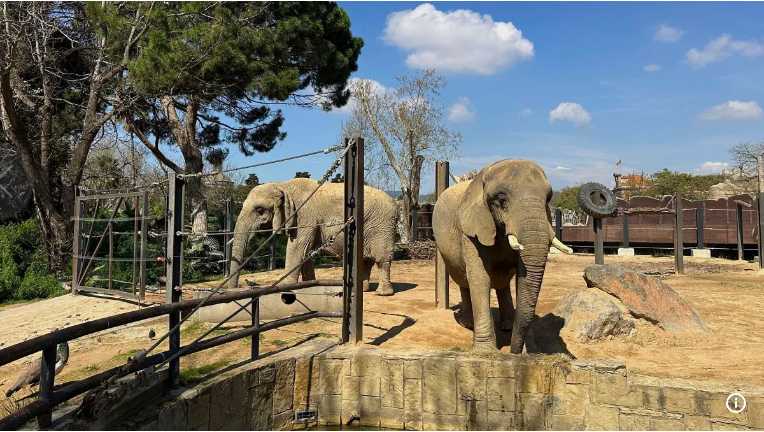"Barcelona Zoo Leads in Geriatric Animal Care, Offering Comfort and Dignity to Ageing Wildlife"

Barcelona Zoo Offers Geriatric Care to Ageing Animals in a New Era of Compassionate Conservation
At the Barcelona Zoo, care goes far beyond feeding schedules and clean enclosures. A quiet but powerful transformation is taking place—one that reflects a growing global shift in how we treat ageing animals who can no longer return to the wild. Each morning, a 40-year-old African elephant named Bully stretches her foot through a metal barrier, where a zookeeper gently scrubs its sole. It’s more than just a “pedicure.” It’s a vital part of her specialised geriatric care routine, paired with slices of fresh apple and a soft, sandy floor to cushion her feet.
This is the new face of modern zoological care—where compassion, comfort, and dignity define the final chapters in an animal’s life.
A New Era for Zoos
Gone are the days when zoos were little more than living museums off exotic animals behind bars. In recent decades, zoos have evolved into centres of education, conservation, and increasingly, sanctuaries for ageing animals who can no longer survive in the wild. According to Pilar Padilla, head of mammal care at Barcelona Zoo, sending elderly animals back to nature is not just impractical—it’s unethical. “It is very likely they wouldn’t survive,” she said.
Instead, zoos like Barcelona’s are focusing on adapting to the complex needs of older animals. This includes redesigned, spacious enclosures that mimic natural habitats, like the zoo’s Sahel-Savannah area, along with veterinary advancements that allow animals to live longer, healthier lives.
Tailored Treatment for Every Species
The Barcelona Zoo is home to a range of senior residents—two African elephants (Susi and Bully), a 15-year-old wolf, a 17-year-old leopard, a tiger of the same age, and a flock of ageing flamingos. For each of them, personalised care is essential.
“Just like older people, elderly animals require more care,” said Martín Zordan, CEO of the World Association of Zoos and Aquariums (WAZA). “Specialised geriatric care is becoming increasingly essential.”
From regular health checks and arthritis treatments to soft diets and behavioural monitoring, the care plan is comprehensive. For Susi and Bully, who no longer have molars due to age-related wear, special food is prepared to ensure proper nutrition. Their daily pedicures help prevent foot problems, while the soft sand beneath their feet is gentle on ageing joints.
Coping with Grief and Emotional Loss
Beyond physical needs, emotional care is also a key part of geriatric animal welfare. The zoo is currently monitoring Susi and Bully following the death of their longtime companion, Yoyo, who died in December at age 54. Susi, now 52, is considered one of the oldest African elephants in captivity. Bully, at 40, is also well into her twilight years.
Padilla and her team, along with researchers from the University of Barcelona, are studying the psychological impact of Yoyo’s death. The study is groundbreaking—one of the first to examine grief in unrelated elephants after the loss of a long-time companion.
“Initially, they both stopped eating,” Padilla said. “But they are now adapting, showing affection, and even sharing food. Susi has taken over the dominant role that Yoyo once had.”
The study underscores the deep emotional lives of animals and the importance of social bonds, even among those not related by blood. The findings could have wide-ranging implications for how zoos worldwide support animals through loss and transition.
The Tooth Test: How Elephants Show Their Age
Unlike humans, elephants don’t get grey hair or wrinkles. Their age is most accurately determined by the condition of their teeth. “They go through six sets off molars during their life,” explained zookeeper José María Santamaría. “When they reach around 40 years old, they lose the last set.”
That’s why dietary adjustments and close dental monitoring are key to ensuring that ageing elephants like Susi and Bully stay healthy and comfortable.
A Model for Ethical Animal Care
Zoos across the globe, including institutions in Baltimore and Baton Rouge, are increasingly spotlighting their geriatric animal care programmes. But Barcelona Zoo stands out for its holistic approach that treats ageing animals not as spectacles, but as cherished individuals deserving respect and empathy.
“We care about these animals living comfortably and leading lives with dignity,” said Zordan.
As zoos continue to embrace their role in conservation and animal welfare, the example set in Barcelona is a reminder that caring for wildlife doesn’t end when an animal is too old to breed or perform. It continues with compassion, science, and an unwavering commitment to giving animals the best quality of life—right up to the very end.
Conclusion
Barcelona Zoo’s approach to geriatric animal care marks a significant evolution in how we view the lives of animals in human care. By prioritising comfort, emotional well-being, and dignity, the zoo is setting a compassionate standard for facilities around the world. Whether it’s through daily pedicures for ageing elephants, soft diets tailored to toothless mouths, or emotional support after the loss of a companion, every detail reflects a deep respect for life at every stage. As animals live longer thanks to modern veterinary care, this thoughtful, holistic model ensures that their golden years are filled with care, comfort, and kindness—not just survival.
- Art
- Causes
- Crafts
- Dance
- Drinks
- Film
- Fitness
- Food
- Jocuri
- Gardening
- Health
- Home
- Literature
- Music
- Networking
- Alte
- Party
- Religion
- Shopping
- Sports
- Theater
- Wellness


